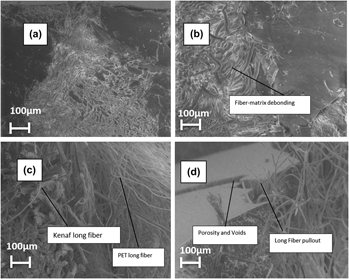Crossref Citations
This article has been cited by the following publications. This list is generated based on data provided by
Crossref.
Zaki Abdullah, Mohamad
Dan-mallam, Yakubu
and
Megat Yusoff, Puteri Sri Melor
2013.
Effect of Environmental Degradation on Mechanical Properties of Kenaf/Polyethylene Terephthalate Fiber Reinforced Polyoxymethylene Hybrid Composite.
Advances in Materials Science and Engineering,
Vol. 2013,
Issue. ,
p.
1.
Dan‐Mallam, Yakubu
Abdullah, Mohamad Zaki
and
Yusoff, Puteri Sri Melor Megat
2014.
The effect of hybridization on mechanical properties of woven kenaf fiber reinforced polyoxymethylene composite.
Polymer Composites,
Vol. 35,
Issue. 10,
p.
1900.
Dan-mallam, Yakubu
Hong, Tan Wei
and
Abdul Majid, Mohd Shukry
2015.
Mechanical Characterization and Water Absorption Behaviour of Interwoven Kenaf/PET Fibre Reinforced Epoxy Hybrid Composite.
International Journal of Polymer Science,
Vol. 2015,
Issue. ,
p.
1.
Dan-Mallam, Yakubu
Abdul Majid, M.S.
and
Abdullah, Mohamad Zaki
2015.
Interfacial Shear Stress in Kenaf/Polyethylene Terephthalate Fiber Reinforced Polyoxymethylene Composite.
Applied Mechanics and Materials,
Vol. 786,
Issue. ,
p.
74.
Dan-mallam, Yakubu
Abdullah, Mohamad Zaki
and
Yusoff, Puteri Sri Melor Megat
2015.
Mechanical Properties of Short and Continuous Kenaf/Pet Fibre Reinforced Polyoxymethylene Composite.
Advanced Composites Letters,
Vol. 24,
Issue. 4,
Dan-Mallam, Yakubu
Abdullah, Mohamad Zaki
and
Megat Yusoff, Puteri Sri Melor
2016.
Influence of Recycling Frequency on Mechanical and Physical Properties of Kenaf Fiber Reinforced Polyoxymethylene Composite.
Journal of Natural Fibers,
Vol. 13,
Issue. 5,
p.
532.
Espinach, Francesc X.
Granda, Luis A.
Tarrés, Quim
Duran, Josep
Fullana-i-Palmer, Pere
and
Mutjé, Pere
2017.
Mechanical and micromechanical tensile strength of eucalyptus bleached fibers reinforced polyoxymethylene composites.
Composites Part B: Engineering,
Vol. 116,
Issue. ,
p.
333.
Chen, Changjie
Chen, Guicui
Li, Xin
Guo, Hongyun
and
Wang, Guohe
2017.
The influence of chemical treatment on the mechanical properties of windmill palm fiber.
Cellulose,
Vol. 24,
Issue. 4,
p.
1611.
Xiong, Xiaoshuang
Shen, Shirley Z.
Alam, Nazmul
Hua, Lin
Li, Xiang
Wan, Xiaojin
and
Miao, Menghe
2018.
Mechanical and abrasive wear performance of woven flax fabric/polyoxymethylene composites.
Wear,
Vol. 414-415,
Issue. ,
p.
9.
Tufail, Muhammad Rizwan
Jamshaid, Hafsa
Mishra, Rajesh
Hussain, Uzair
Tichy, Martin
and
Muller, Miroslav
2021.
Characterization of Hybrid Composites with Polyester Waste Fibers, Olive Root Fibers and Coir Pith Micro-Particles Using Mixture Design Analysis for Structural Applications.
Polymers,
Vol. 13,
Issue. 14,
p.
2291.
Yurtbasi, Zuhal
Kuyumcu, Mustafa
Kurt, Gökçe
and
Kasgoz, Alper
2022.
Evaluation of morphological, rheological, mechanical, and dielectric properties of aluminum dross filled polyoxymethylene (POM) composites.
Polymer Composites,
Vol. 43,
Issue. 10,
p.
7143.
Wisetkhamsai, Kraiwut
Patthaveekongka, Weerawat
and
Arayapranee, Wanvimon
2023.
Effect of LNR-g-MMA on the Mechanical Properties and Lifetime Estimation of PLA/PP Blends.
Polymers,
Vol. 15,
Issue. 7,
p.
1712.
Ajayi, Nelson Ehiosu
Rusnakova, Sona
Ajayi, Augustina Ebele
Ogunleye, Raphael Olabanji
Agu, Stanley Onyedekachi
and
Amenaghawon, Andrew Nosakhare
2025.
A comprehensive review of natural fiber reinforced Polymer composites as emerging materials for sustainable applications.
Applied Materials Today,
Vol. 43,
Issue. ,
p.
102666.



